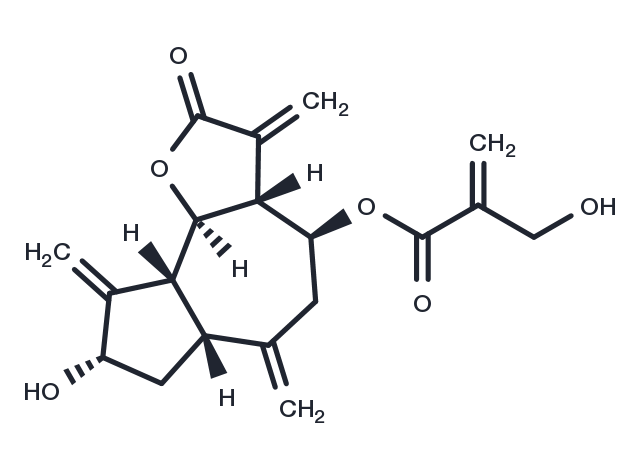Powder: -20°C for 3 years | In solvent: -80°C for 1 year


Cynaropicrin is a potent activator of the AhR-Nrf2-Nqo1 pathway, and could therefore be applied to prevention of UVB-induced photo aging; it may be a potential anticancer agent against some leukocyte cancer cells such as lymphoma or leukemia, through pro-apoptotic activity.

| Pack Size | Availability | Price/USD | Quantity |
|---|---|---|---|
| 2 mg | 5 days | $ 116.00 | |
| 1 mL * 10 mM (in DMSO) | 5 days | $ 279.00 |
| Description | Cynaropicrin is a potent activator of the AhR-Nrf2-Nqo1 pathway, and could therefore be applied to prevention of UVB-induced photo aging; it may be a potential anticancer agent against some leukocyte cancer cells such as lymphoma or leukemia, through pro-apoptotic activity. |
| In vitro | Cynaropicrin strongly inhibited TNF-alpha release from lipopolysaccharide-stimulated murine macrophage, RAW264.7 cells, and differentiated human macrophage, U937 cells, proved to produce notable amount of TNF-alpha. It also potently attenuated the accumulation of NO released from lipopolysaccharide- and interferon-gamma-stimulated RAW264.7 cells in a dose-dependent manner. In addition, the immunosuppressive effects of the compound on lymphocyte proliferation in response to mitogenic stimuli were examined. Cynaropicrin also dose-dependently suppressed the proliferation of lymphocytes from splenocytes and interleukin-2-sensitive cytotoxic T lymphocyte, CTLL-2 cells, stimulated by lipopolysaccharide, concanavalin A, phytohemagglutinin and interleukin-2. However, treatment with sulphydryl compound, L-cysteine, abrogated all these inhibitory effects. |
| Source |
| Molecular Weight | 346.37 |
| Formula | C19H22O6 |
| CAS No. | 35730-78-0 |
Powder: -20°C for 3 years | In solvent: -80°C for 1 year
DMSO: 50 mg/mL (144.35 mM)
You can also refer to dose conversion for different animals. More
bottom
Please see Inhibitor Handling Instructions for more frequently ask questions. Topics include: how to prepare stock solutions, how to store products, and cautions on cell-based assays & animal experiments, etc.
Cynaropicrin 35730-78-0 Apoptosis Immunology/Inflammation Others IL Receptor TNF inhibitor inhibit
